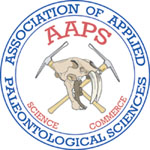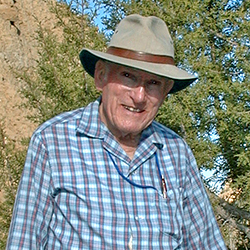 |
AAPS, Association of Applied Paleontological SciencesBusiness Office: 96 East 700 South, Logan, UT 84321-5555, Phone: 435-744-3428 |
 |
AAPS, Association of Applied Paleontological SciencesBusiness Office: 96 East 700 South, Logan, UT 84321-5555, Phone: 435-744-3428 |
|
Home AAPS Advocate AAPS-Journal Awards Business Members Bylaws Code of Ethics Fossil Dealers Guide Fossil Ivory Ban Info Fossil Laws Fossil Theft Alerts Grants History of AAPS Meetings Membership Application Members Memorial Photo Scale President's Message Press Releases Sample Collecting Contract Sample Newsletter Scholarships |
William A "Bill" Cobban
|
|
April, 2015 
Dr. W.A. "Bill" Cobban, one of the most highly respected and published geologist/paleontologists of all time, passed away peacefully in his sleep in the morning of April 21, 2015 at the age of 98 in Lakewood, Colorado. Bill was an extraordinary geologist, field collector, biostratigrapher and paleontologist who spent nearly his entire career working for one of the oldest and most respected US government institutions, the US Geological Survey (USGS). In a career that spanned more than 70 years he fundamentally changed our understanding of the Upper Cretaceous Western Interior geology through its fossils and made it explicable, logical and comprehensible. Dr. Cobban was born near Great Falls, Montana, in 1916. He attended the University of Montana in Missoula and in 1940 went to work for Carter Oil Company (now Exxon) as a geologist, stratigrapher and mapmaker. In 1946, Bill attended Johns Hopkins University receiving his PhD in 1949. He began his USGS career in 1948 with fieldwork on the Cretaceous deposits of southeastern Montana and northwestern South Dakota. During his years at the USGS, Bill mentored under John B. Reeside, Jr., the father of modern Western Interior biostratigraphy, and collected and published with close friends and colleagues James Gill and Glenn Scott. These geologists spent most of their careers collecting, mapping and publishing on the geology, stratigraphy and the invertebrate fauna of the Western Interior Upper Cretaceous marine sediments. The collections that these geologists assembled are unequaled anywhere and their research refined our ideas of biostratigraphy within the marine Western Interior. Throughout the last 70+ years, Bill also collaborated with dozens of other respected geologists and paleontologists worldwide. During his career, Dr. Cobban visited and collected more Cretaceous outcrops than any other geologist. From his records he created a USGS database that contains 14,000 Mesozoic mollusk localities from the Western Interior alone, not to mention the untold dozens of other localities he visited in the southern, southeastern and eastern United States. At every locality, Bill took measurements (whenever possible), collected fossils and made impeccable notes. His publications show his uncanny abilities of observation, interpretation and deduction. Bill has shared his knowledge with all those around him and with all those who visited him at Denver or accompanied him in the field. Dr. Cobban is responsible for naming and defining most of the 71 Upper Cretaceous ammonite zones of the Western Interior. Along with colleague John Obradovich, he was able to assign the most accurate and accepted Ar/Ar dating to most of the Upper Cretaceous bentonite layers. These zones and their corresponding ages are recognized and used by geologists worldwide as the standard for Upper Cretaceous zonation of the US Western Interior. Bill was involved in the systematic descriptions of hundreds of invertebrate fossils naming at least 35 genera, 2 subgenera, 215 species, and 11 varieties of ammonites along with 18 species of inoceramids. Bill was a disciplined researcher who authored and co-authored more than 330 papers on the invertebrates, biostratigraphy and geology of the North American Late Cretaceous. He continued to publish nearly up to the time of his death. Bill had four ammonite genera, one plant genus and 17 species of invertebrates named after him. In 1974 he received the Meritorious Service Award, the second-highest departmental honor award that can be granted to a career employee in the Department of the Interior. In 1985 he was awarded the Distinguished Geologist Pioneer Award which is awarded by the Paleontological Society to recognize outstanding contributions in paleontology. In 1986 he was given the Distinguished Service Award, the highest departmental honor award that can be granted to a career employee of the Department of the Interior. In 1990 he was awarded the Raymond C. Moore Paleontology Medal by the Society for Sedimentary Geology (SEPM) International, in recognition of "Excellence in Paleontology. In 2004, his peers at the 6th International Symposium on Cephalopods Past and Present honored Bill for his unselfish, meritorious, lifetime work on the Late Cretaceous ammonites of North America. In 2006 a paleontological symposium was held at the Colorado School of Mines as a tribute to the life and career of Dr. Cobban. Bill was preceded in death by his parents, his wife of 75 years Ruth, and grandson Colt Baird. He is survived by his daughter Georgina Egbert, sons Robert and Bill and by hundreds of close friends and colleagues who were fortunate to have gotten to know him. Dr. Cobban will be remembered through his many publications and dearly remembered by each and everyone who had the opportunity to visit this great man and the collections he helped acquire at the Denver Federal Center Building 25. He left this world a much better place and all who knew him were enriched by his friendship and knowledge. |
|
A.A.P.S. DIRECTORY || Home || About AAPS || Board Members || Membership Application |
|
Supporting Paleontology through ethical Commerce, Education and Cooperation https://www.aaps.net/William-A-Cobban-Obituary.htm Last Updated: July 2, 2015Last Updated: December 2, 2025 Copyright © 1995-2025 Association of Applied Paleontological Sciences |